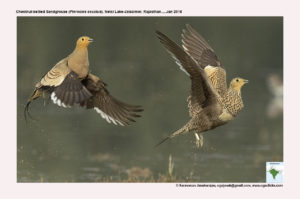Chestnut-bellied Sandgrouse

Chestnut-bellied Sandgrouse Pterocles exustus
Etymology :
- Pterocles :Greek word pteron -wing; kles – notable, splendid
- Exustus : latin word for burnt , scorched derived from exurereto burn up
Vernacular Names :Sind:Batebar, Bateban, Hindi: KuharBhatteetar, Pun:Bhattitar, Guj:Deshibatado, Vagadavubatavdo, Mar: Pokurdee, Pokundi, Ta: Kalkoudari, Kan: Kalgojalhakki,Te: Jam polanki
Distribution in India: Widespread resident except Himalayas and Eastern region in India.
Description: Size of 31–33 cm; wt. of male is 170–290g, wt. of female is 140–240 g; wingspan of 48–51 cm. It’s a small Sandgrouse, with elongated central tail feathers, dark underwing and blackish belly and unmarked head. The male has narrow pectoral band and chestnut brown belly darkening towards rear; bill is slate blue with darker tip; orbital ring is pale greenish. The female is. more mottled above; shows “tricoloured” ventral pattern. The juvenile has short tail; upperparts are more densely barred and underparts less contrasting.
Habitat: It is found in bare semi-desert, often with scattered thorny scrubs or trees, marginal cultivation, fallow fields, wasteland and grassland. It is found from lowland up to 1500 m.
Food habits: It eats seeds, which are often hard and very small; legumes, cultivated grains in stubble, shoots and insects on occasions. It feeds during cooler hours of morning and afternoon and drinks Large concentration next to a water point. 2–3 hours after sunrise, while in very hot weather some individuals drink again before sunset.
Breeding habits: They breed in variability related to local rainfall: Jan–Apr in South India; Mar–May in North India; Apr–Jun in Arabia, Sudan, Ethiopia and Somalia; Feb–Nov in Kenya; May–Nov in N Tanzania; and Mar–Jul in Mali and Senegambia. The nest is simple scrape in ground, lined scantily or not at all. They lay a clutch of 2- 3 eggs. The incubation period is 22–23 days, with male incubating by night.